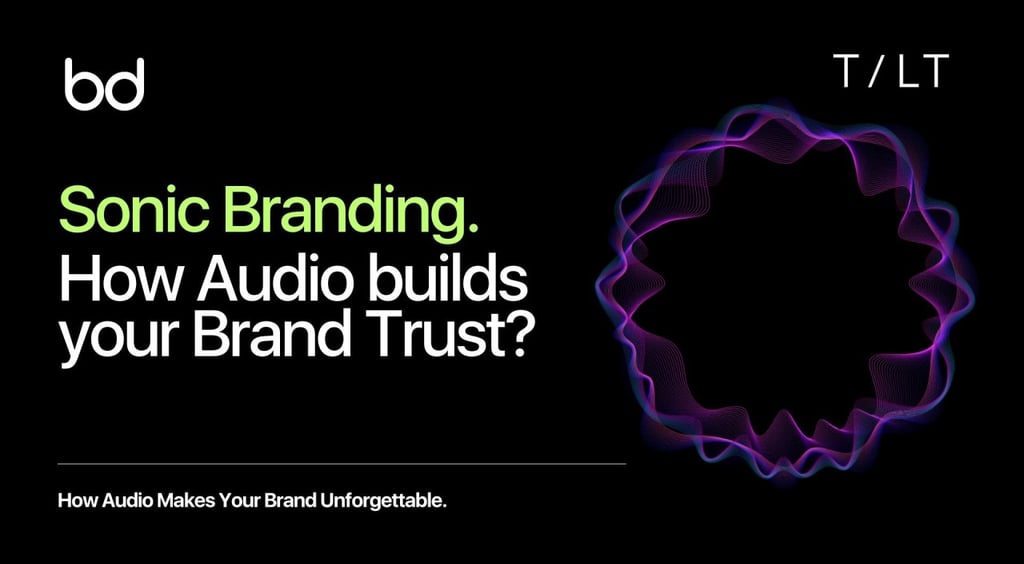Sonic Branding: How Audio Makes Your Brand Unforgettable
This newsletter dives deep into the scientific, psychological, and market-driven perspectives that make sonic branding a theory you can’t afford to ignore.
Brand Blinks Global
4 min read


Branding has long been shaped by colors, logos, and words, but in today’s crowded media landscape, sound is the new differentiator.
Sonic branding, the strategic use of audio to express identity and evoke emotion, has moved from ad jingles to essential brand assets spanning digital, retail, healthcare, B2B, and more.
This newsletter dives deep into the scientific, psychological, and market-driven perspectives that make sonic branding a theory you can’t afford to ignore.
The Science of Sound: Why Audio Cuts Through
Studies show that sound lingers in the brain longer, triggers a strong emotional response, and forges faster brand associations. In one experiment, Netflix’s “ta-dum” achieved a 94% sonic logo recognition rate, surpassing most visual identities. Why? Audio cues tap directly into our subconscious, connecting brand memories to emotions and even physical responses such as increased heart rate.
The Psychology: How Sonic Branding Influences Behavior
Cognitive and neuroscientific research ties auditory stimuli to behaviors like engagement, recall, and even purchase intent.
Brands using sonic assets, jingles, short sound logos, or ambient design see measurable increases in user retention and brand favorability:
Recall: Ads with sonic branding are 8.5x more memorable than visual-only ads.
Recognition: 139 of 250 leading brands now use a sonic logo. Customers link these sounds to brand trust and differentiation.
Emotional resonance: Gatorade’s branded playlists and MasterCard’s sonic identity respectively boosted favorability and trust among core audiences.
The Theory: Components That Make Sonic Branding Work
Maximizing sonic impact starts with a tailored brand strategy and development.
Key elements:
Consistency: Like color, your audio “palette” should be uniform across touchpoints.
Congruence: Sonic cues must match brand personality, avoiding the common pitfall where mismatched sound damages perception.
Ownership: Custom audio, rather than licensed popular tunes, protects brand value and makes your sonic identity ownable, scalable, and distinctive.
Repetition: Reinforcing sonic assets in every experience, from app notifications to podcast intros, ingrains familiarity for deeper recall.
Industry Focus: Sonic Branding Beyond B2C
Retail and Fast Food: Sonic marks (McDonald’s “I’m Lovin’ It,” Old Spice jingles) drive impulse buying and instant emotion.
B2B & Tech: Audio branding is exploding in software, financial, and SaaS sectors. UI sounds, podcast intros, voice assistant cues, all enhance perceived innovation and reliability.
Healthcare & Wellness: Medtech and health apps use ambient sounds to convey trust and safety, making platforms feel approachable.
How to Orchestrate Sonic Branding
Start with a brand audit to pinpoint where sound fits in your identity. Then, build or refresh your audio assets in partnership with branding consulting:
Map customer touchpoints: website, product, ads, app, and define the moments where branded sounds can trigger emotion.
Develop custom sonic assets (voiceover, logo, ambient soundscapes) with your branding and designing team, ensuring congruence with your brand visuals and copy.
Collaborate on content with top-tier content writing and copywriting professionals to script stories, guide audio narrative, and echo the sonic identity in all brand communication.
Future-proof sonic assets with expert website design and development so they function seamlessly in digital products and voice search environments.
Best Practices for UX and Sonic Branding
Poor sonic branding (incongruent tones, unpleasant alerts, or overused sounds) reduces engagement and pushes users away. Top brands incorporate ux audit processes, testing audio touchpoints for accessibility, consistency, and emotional impact.
Trends & Stats: Why Audio Is Rising
77% of MasterCard customers reported increased brand trust after hearing its sonic identity. rebelliongroup
MasterCard’s launch sparked a 22% rise in brands pursuing sonic strategies.
Audio-first digital users (Gen Z, podcast listeners) form deeper bonds with brands featuring intentional music and sounds. vezadigital
Social media and voice search optimization make sonic branding relevant in both B2B and B2C contexts. emb
Turn Theory into Unforgettable Practice
At Brand Blinks Global, demand generation strategies now go beyond sight; every auditory element is mapped to boost engagement, build memory, and turn fleeting attention into lasting recall. We engineer sound for impact. Your brand’s audio becomes a strategic asset across industries:
Retailers use sonic branding for instant recall and emotion.
B2B firms guide buyer journeys and channel authority with branded podcast intros, UI chimes, and more.
Healthcare and wellness brands relax and reassure with ambient tones, improving user trust at every interaction.
The New Age of Brand Memory Is Sonic
If your brand is still silent, it’s time to listen. As markets saturate, audio is where brands become unforgettable, where science meets story, and memory meets business results.
Is your brand’s sound working as hard as your visuals? Let’s orchestrate your sonic identity together.









© 2025 BRNDXMORPH Media Worldwide Private Limited. All rights reserved
Brand Blinks Global is an independent global brand intelligence x transformation company.
The trademarks, logos, and service marks displayed on this site are the property of their respective owners.
"Brand Blinks Global," "Brand Blinks," "Made for the Uncommon," and the "bd" logo are trademarks or registered trademarks of BRNDXMORPH Media Worldwide Private Limited.
RESOURCES
INTELLIGENCE
BUSINESS
TALENT
COVERAGE
EXPLORE
Made for the Uncommon


When your brand grows, others rise too. 2% of your project empowers a nonprofit we back together every year.


